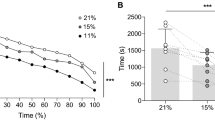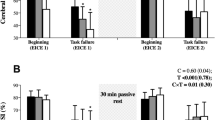Abstract
Increasing inspiratory oxygen tension improves exercise performance. We tested the hypothesis that this is partly due to changes in muscle activation levels while perception of exertion remains unaltered. Eleven male subjects performed two 20-km cycling time-trials, one in hyperoxia (HI, FiO2 40%) and one in normoxia (NORM, FiO2 21%). Every 2 km we measured power output, heart rate, blood lactate, integrated vastus lateralis EMG activity (iEMG) and ratings of perceived exertion (RPE). Performance was improved on average by 5% in HI compared to NORM (P < 0.01). Changes in heart rate, plasma lactate concentration and RPE during the trials were similar. For the majority of the time-trials, power output was maintained in HI, but decreased progressively in NORM (P < 0.01) while it increased in both trials for the last kilometre (P < 0.0001). iEMG was proportional to power output and was significantly greater in HI than in NORM. iEMG activity increased significantly in the final kilometer of both trials (P < 0.001). This suggests that improved exercise performance in hyperoxia may be the result of increased muscle activation leading to greater power outputs. The finding of identical RPE, lactate and heart rate in both trials suggests that pacing strategies are altered to keep the actual and perceived exercise stress at a similar level between conditions. We suggest that a complex, intelligent system regulates exercise performance through the control of muscle activation levels in an integrative manner under conditions of normoxia and hyperoxia.






Similar content being viewed by others
References
Abbiss CR, Laursen PB (2005) Models to explain fatigue during prolonged endurance cycling. Sports Med 35:865–898
Amann M, Eldridge MW, Lovering AT, Stickland MK, Pegelow DF, Dempsey JA (2006) Arterial oxygenation influences central motor output and exercise performance via effects on peripheral locomotor muscle fatigue in humans. J Physiol 575:937–952
Bigland-Ritchie B (1981) EMG/force relations and fatigue of human voluntary contractions. Exerc Sports Sci Rev 11:75–117
Bilodeau M, Schindler-Ivens S, Williams DM, Chandran R, Sharma SS (2003) EMG frequency content changes with increasing force and during fatigue in the quadriceps femoris muscle of men and women. J Electromyogr Kinesiol 13:83–92
Borg GA (1982) Psychophysical bases of perceived exertion. Med Sci Sports Exerc 14:377–381
Diamant B, Karlsson J, Saltin B (1968) Muscle tissue lactate after maximal exercise in man. Acta Physiol Scand 72:383–384
Eiken O, Hesser CM, Lind F, Thorsson A, Tesch PA (1987) Human skeletal muscle function and metabolism during intense exercise at high O2 and N2 pressures. J Appl Physiol 63:571–575
Farina D, Merletti R, Enoka RM (2004) The extraction of neural strategies from the surface EMG. J Appl Physiol 96:1486–1495
Foster C, de Koning JJ, Hettinga F, Lampen J, La Clair KL, Dodge C, Bobbert M, Porcari JP (2003) Pattern of energy expenditure during simulated competition. Med Sci Sports Exerc 35:826–831
Gandevia SC (2001) Spinal and supraspinal factors in human muscle fatigue. Physiol Rev 81:1725–1789
Graham TE, Pedersen PK, Saltin B (1987) Muscle and blood ammonia and lactate responses to prolonged exercise with hyperoxia. J Appl Physiol 63:1457–1462
Häkkinen K (1993) Neuromuscular fatigue and recovery in male and female athletes during heavy resistance exercise. Int J Sports Med 14:53–59
Haseler LJ, Richardson RS, Videen JS, Hogan MC (1998) Phosphocreatine hydrolysis during submaximal exercise: the effect of FiO2. J Appl Physiol 85:1457–1463
Hepple RT (2002) The role of O2 supply in muscle fatigue. Can J Appl Physiol 27:56–69
Hettinga FJ, de Koning JJ, Broersen FT, Van Geffen P, Foster C (2006) Pacing strategy and the occurrence of fatigue in 4000-m cycling time trials. Med Sci Sports Exerc 38:1484–1491
Hogan MC, Welch HG (1984) Effect of varied lactate levels on bicycle ergometer performance. J Appl Physiol 57:507–513
Hogan MC, Richardson RS, Haseler LJ (1999) Human muscle performance and PCr hydrolysis with varied inspired oxygen fractions: a 31P-MRS study. J Appl Physiol 86:1367–1373
Howley ET, Cox RH, Welch HG, Adams RP (1983) Effect of hyperoxia on metabolic and catecholamine responses to prolonged exercise. J Appl Physiol 54:59–63
Hunter AM, St Clair GA, Lambert M, Noakes TD (2002) Electromyographic (EMG) normalization method for cycle fatigue protocols. Med Sci Sports Exerc 34:857–861
Hunter AM, St Clair Gibson A, Lambert DL, Nobbs L, Noakes TD (2003) Effects of supramaximal exercise on the electromyographic signal. Br J Sports Med 37:296–299
Ingen Schenau GJ, Jacobs R, de Koning JJ (1991) Can cycle power predict sprint running performance? Eur J Appl Physiol Occup Physiol 63:255–260
Jacobs I, Kaiser P (1982) Lactate in blood, mixed skeletal muscle, and FT or ST fibres during cycle exercise in man. Acta Physiol Scand 114:461–466
Jacobs I, Tesch PA, Bar-Or O, Karlsson J, Dotan R (1983) Lactate in human skeletal muscle after 10 and 30 s of supramaximal exercise. J Appl Physiol 55:365–367
Karlsson J, Saltin B (1970) Lactate, ATP, and CP in working muscles during exhaustive exercise in man. J Appl Physiol 29:596–602
Kayser B, Narici M, Binzoni T, Grassi B, Cerretelli P (1994) Fatigue and exhaustion in chronic hypobaric hypoxia: influence of exercising muscle mass. J Appl Physiol 76:634–640
Lambert EV, St Clair Gibson A, Noakes TD (2005) Complex systems model of fatigue: integrative homoeostatic control of peripheral physiological systems during exercise in humans. Br J Sports Med 39:52–62
Linnarsson D, Karlsson J, Fagraeus L, Saltin B (1974) Muscle metabolites and oxygen deficit with exercise in hypoxia and hyperoxia. J Appl Physiol 36:399–402
Linossier MT, Dormois D, Arsac L, Denis C, Gay JP, Geyssant A, Lacour JR (2000) Effect of hyperoxia on aerobic and anaerobic performances and muscle metabolism during maximal cycling exercise. Acta Physiol Scand 168:403–411
MacLaren DP, Gibson H, Parry-Billings M, Edwards RH (1989) A review of metabolic and physiological factors in fatigue. Exerc Sport Sci Rev 17:29–66
Marino FE, Lambert MI, Noakes TD (2004) Superior performance of African runners in warm humid but not in cool environmental conditions. J Appl Physiol 96:124–130
Marsden CD, Meadows JC, Merton PA (1983) ‘Muscular wisdom” that minimizes fatigue during prolonged effort in man: peak rates of motoneuron discharge and slowing of discharge during fatigue. Adv Neurol 39:169–211
Mateika JH, Duffin J (1994) The ventilation, lactate and electromyographic thresholds during incremental exercise tests in normoxia, hypoxia and hyperoxia. Eur J Appl Physiol Occup Physiol 69:110–118
McLester JR Jr (1997) Muscle contraction and fatigue. The role of adenosine 5′-diphosphate and inorganic phosphate. Sports Med 23:287–305
Nielsen HB, Boushel R, Madsen P, Secher NH (1999) Cerebral desaturation during exercise reversed by O2 supplementation. Am J Physiol 277:H1045–H1052
Noakes TD, Peltonen JE, Rusko HK (2001) Evidence that a central governor regulates exercise performance during acute hypoxia and hyperoxia. J Exp Biol 204:3225–3234
Noakes TD, St Clair Gibson A (2004) Logical limitations to the “Catastrophe” models of fatigue during exercise in humans. Br J Sports Med 38:648–649
Nummela A, Vuorimaa T, Rusko HK (1992) Changes in force production, blood lactate and EMG activity in the 400-m sprint. J Sports Sci 10:217–228
Peltonen JE, Rantamäki J, Niittymäki SPT, Sweins K, Viitasalo JT, Rusko HK (1995) Effects of oxygen fraction in inspired air on rowing performance. Med Sci Sports Exerc 27:573–579
Peltonen JE, Rantamäki J, Niittymäki SPT, Sweins K, Viitasalo JT, Rusko HK (1997) Effects of oxygen fraction in inspired air on force production and electromyogram activity during ergometer rowing. Eur J Appl Physiol 76:495–503
Peltonen JE, Leppavuori AP, Kyro K-P, Makela P, Rusko HK (1999) Arterial haemoglobin oxygen saturation is affected by FiO2 at submaximal running velocities in elite athletes . Scand J Med Sci Sports 9:265–271
Peltonen JE, Tikkanen HO, Ritola JJ, Ahotupa M, Rusko HK (2001a) Oxygen uptake response during maximal cycling in hyperoxia, normoxia and hypoxia. Aviat Space Environ Med 72:904–911
Peltonen JE, Tikkanen HO, Rusko HK (2001b) Cardiorespiratory responses to exercise in acute hypoxia, hyperoxia and normoxia. Eur J Appl Physiol 85:82–88
St Clair Gibson A, Schabort EJ, Noakes TD (2001) Reduced neuromuscular activity and force generation during prolonged cycling. Am J Physiol Reg Int Comp Physiol 281:R187-R196
Steinacker JM, Marx TR, Marx U, Lormes W (1986) Oxygen consumption and metabolic strain in rowing ergometer exercise. Eur J Appl Physiol 55:240–247
Taylor AD, Bronks R, Smith P, Humphries BB (1997) Myoelectric evidence of peripheral muscle fatigue during exercise in severe hypoxia: some references to m. vastus lateralis myosin heavy chain composition. Eur J Appl Physiol 75:151–159
Tucker R, Rauch L, Harley YXR, Noakes TD (2004) Impaired exercise performance in the heat is associated with an anticipatory reduction in skeletal muscle recruitment. Pflugers Arch 448:422–430
Westerblad H, Allen DG, Lannergren J (2002) Muscle fatigue: lactic acid or inorganic phosphate the major cause? News Physiol Sci 17:17–21
Wilber RL, Holm PL, Morris DM, Dallam GM, Cannon J (2003) Effect of FiO2 on Physiological Responses and cycling performance and moderate altitude. Med Sci Sports Exerc 35:1153–1159
Acknowledgments
Funding for this experiment was provided by Medical Research Council of South Africa, the University of Cape Town Harry Crossley and Nellie Atkinson Staff Research Funds, Discovery Health and the National Research Foundation of South Africa through the THRIP initiative.
Author information
Authors and Affiliations
Corresponding author
Rights and permissions
About this article
Cite this article
Tucker, R., Kayser, B., Rae, E. et al. Hyperoxia improves 20 km cycling time trial performance by increasing muscle activation levels while perceived exertion stays the same. Eur J Appl Physiol 101, 771–781 (2007). https://doi.org/10.1007/s00421-007-0458-z
Accepted:
Published:
Issue Date:
DOI: https://doi.org/10.1007/s00421-007-0458-z




